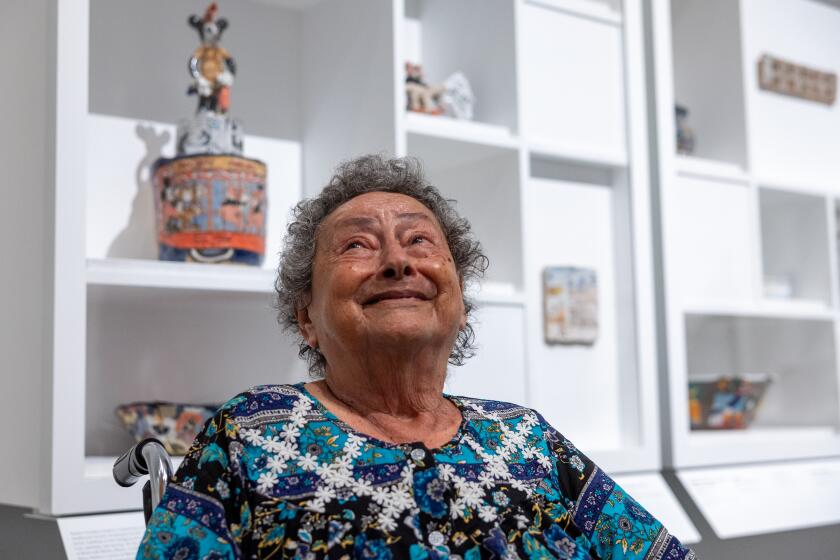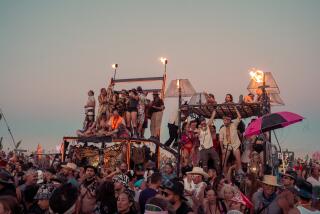
- Share via
- On the 10th anniversary of artist Leonard Knight’s death, supporters gather to repair the desert landmark, damaged by rain earlier this year.
- A large section of the roof collapsed this summer.
- Knight’s legacy can be seen in the nearby community of East Jesus, where a massive new installation has risen.
Slab City — Leonard Knight, a Korean war veteran and itinerant auto mechanic, showed up here in 1984 with the ambition of launching a 200-foot-tall balloon that he’d spent 10 years sewing by hand. Emblazoned in enormous letters on the side of the balloon was “God Is Love ” — a reflection of Knight’s goal to bring everyone closer to God.
Knight never was able to get his balloon airborne, but he did spread his “God Is Love” message through another project: the intriguing desert monument known as Salvation Mountain, which not only remains standing but also is growing in reputation, 10 years after Knight died at 82.
Knight’s supporters recently turned out to celebrate that 10th anniversary by lending a hand to preserve his creation, which sits on the decommissioned Marine base Camp Dunlap near the Salton Sea, about three hours east of Los Angeles and an hour and a half south of Palm Springs.
For the record:
9:28 a.m. Nov. 26, 2024An earlier version of this article misstated the location of Salvation Mountain. It lies east, not west, of L.A. The article also misspelled Camp Dunlap as Dunlop.
Fans and friends gathered in late October to work on the mountain and reminisce about the kindly recluse who over 25 years created an enormous, candy-colored paean to his faith. Salvation Mountain is regarded by many as one of the most striking pieces of outsider-art sculpture in America. This year Imperial County recognized its enduring importance by designating it a “historically significant property.”
“Even if I had been in 110-degree heat all day, every time I left Salvation Mountain, I felt totally refreshed driving home,” said Daniel Paul, an architectural historian who started visiting the mountain in 1995. “Leonard was such a positive person, it was just rejuvenating spending time with him.”

Knight took the failure of his balloon project as God’s way of challenging him to build a bigger and more permanent symbol of God’s love. With no artistic training, Knight rededicated his life to fulfilling his spiritual vision, all while living at the base of his sculpture without plumbing or electricity.
Donated straw bales served as a foundation, and Knight sculpted over them with adobe and then sealed the designs with donated paint. Even as Salvation Mountain won admiration, Knight remained a paragon of humility; he never called himself an artist or took credit for his creation. He maintained that God was the artist and he merely held the brush.
People call it a mountain, but it’s just 150 feet across and five stories tall, jutting skyward like a candy-colored, Jesus-inspired hallucination brought to life on the subdued pastel palette of the desert.
“Leonard would say it was a spiritual expression that came through him that wasn’t his,” Paul said. “He never took any personal credit for his achievement. It’s an absolutely humble and truly remarkable way to live life.”
Knight faced myriad obstacles in the building of Salvation Mountain. His first attempt to build his mountain collapsed during a heavy rainstorm. The current iteration is a better-constructed design whose wild pastiche of psychedelic colors and abstracted designs still conveys a childlike fervor and intensity.

Knight sought no permission or permits to build his five-story creation, which sits on state property — a fact that has long created uncertainty about Salvation Mountain. In 1994 Imperial County tried to push Knight off the land but failed after a groundswell of public support for the artist.
The nonprofit Salvation Mountain Inc. manages the artwork and is working to get legal ownership of the property. The group’s president, Bob Levesque, said he’s confident that they will be able to secure a lease with the California State Lands Commission.
“We’re going to be taking some aggressive steps going into the new year,” Levesque said. “Hopefully, within four to six months we’ll have a lease on the property.”
Maintaining the property is a huge challenge. Heavy rains last year caused the part of the mountain that Knight called the Museum to collapse. Knight intended the Museum, which is a fantastical series of brightly decorated rooms filled with painted trees, to take the form of an inflating balloon in tribute to the failed balloon project.
His first Palm Springs AIDS memorial looked like an anus, critics said, so artist Phillip K. Smith III went back to the drawing board and set out to win over skeptics in the community. The City Council approved the new design Thursday.
Rain has leaked through cracks in the paint and saturated the hay bales forming the ceiling. With no framing to support them, the bales collapsed, closing the Museum to the public.
“A few bales at a time have fallen since the beginning of 2023, but a much larger section came down from the roof and over the entrance during the summer months this year,” Levesque said. “We have a conservator team coming in December to begin evaluating the restoration so we can plan for the complete restoration of the Museum.”
Salvation Mountain faces other major challenges. Funds for the mountain are scarce since contributions mostly come from a visitors donation box. Additionally, the extreme desert climate as well as constant foot traffic causes continuous wear and tear and requires daily maintenance, and keeping the unfenced mountain secure from vandals and miscreants is no easy task. Levesque acknowledged the scale of the challenge before them, but he remains optimistic that the Museum will be restored and that Salvation Mountain will continue to draw art lovers and curiosity seekers from around the world.
“We’ve been very fortunate,” Levesque said. “We call it mountain magic. So hopefully there’ll be some more magic but, in the meantime, we’ve just got to keep chipping away and find the funding wherever it’s hiding from us.”

The lasting legacy of Salvation Mountain and the growing presence of outsider artists in this part of the desert can be seen in the nearby artist community of East Jesus. East Jesus, named for its remoteness, sits on the edge of Slab City, a community of squatters who live in campers and RVs on the concrete slabs left behind when Camp Dunlap closed.
East Jesus was the brainchild of Charlie Russell, a regular volunteer at Salvation Mountain and a friend of Knight’s. In 2007 Russell moved into Slab City permanently and took over what had been the local scrapyard, repurposing the cast-off items into striking sculptures. Russell invited other artists to contribute their work created from recycled materials, and now East Jesus spans 30 acres.
By design, East Jesus is a wide-ranging and fascinatingly eclectic creation that continues to expand and grow and attract new artistic creations. Unlike Salvation Mountain, an artist nonprofit tied to East Jesus was able to purchase its land from the state in 2016, so its future is not in doubt.
As LACMA exhibits decades of ceramics, painting and drawing, the artist reflects on the devastating sacrifices she made along the way. “I paid my price, I can tell you.”

“Charlie loved the idea of the never-ending art project,” said Jenn Nelson, the president of Chasterus Foundation, the nonprofit behind East Jesus. “East Jesus is an experimental, habitable and sustainable art installation. What ties it all together is that all the art is made from discards and materials that are effectively unwanted.”
The sculptures made from rusting car parts and other discards can look off-putting or even dangerous, an idea Russell and his fellow artists have fun with. Nelson walked over to a rather scary-looking installation and pointed out its various components.
“This is called ‘The Most Dangerous Playground,’” Nelson said. “You have ‘The Teeter Totter of Death,’ ‘The Cheese Grater Slide,’ ‘The Rustiest Swing Set’ and ‘The Monkey Bars of Disappointment.’”
The Salton Sea’s gradual collapse has continued over decades. In recent times, though, it has seen a revival of sorts, around a growing community of artists.
The lofty “Teeter Totter of Death” is a particularly dangerous-looking contraption that has at its base a large collection of old bowling balls.
“The bowling balls are there so that you and your riding partner can counterweight as you get on,” Nelson said.

When asked if she ever gets on it, Nelson responded, “Yes, it’s terrifying.”
The most recent addition to East Jesus is a huge robot-themed installation by Palm Springs artist Kenny Irwin Jr., known for his backyard “Robolights” installation. The East Jesus work sits off by itself and resembles a salvage-built castle replete with ramparts and towers, and it’s chockablock with Irwin’s signature scrapyard robots.
“One of the things that we’re very lucky to have is this unintentional art renaissance here in the Coachella Valley,” Nelson said. “What we’ve seen over the last 20 years is this amazing growth of incredible art projects that just couldn’t exist anywhere else in Southern California.”

More to Read
The biggest entertainment stories
Get our big stories about Hollywood, film, television, music, arts, culture and more right in your inbox as soon as they publish.
You may occasionally receive promotional content from the Los Angeles Times.














